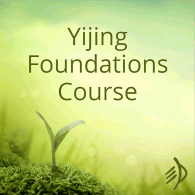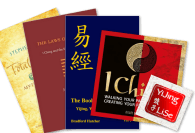Hexagram 46, Pushing Upward, has to do with step-by-step progress onward and upward, and the effort of the climb. It also has to do with offerings: Harmen, in his fascinating article on the hexagram, says,
“Sheng was the name of a certain sacrifice, and because of the close resemblance between the old forms of sheng and dou, I believe that sheng could refer to a sacrifice made to the constellation beidou [the Big Dipper].”
He also mentions that the name of this hexagram in both Fuyang and Mawangdui manuscripts is a homophone of the received name, and means to make an offering at a high place – related to the ancient tradition of climbing a sacred mountain to make an offering.
So Hexagram 46 has to do not just with progress but with the desire for connection and participation at a higher level – with the implication that to reach that level, you need to do the work, and climb.
In readings over the years at the I Ching Community, Hexagram 46 has described the desire for more fulfilling work, for a fuller relationship (or for marriage), for democracy and social change. It’s pointed to the need to embark on a project, make progress, take steps to improve one’s financial situation.
What also comes across clearly, browsing through past threads, is that Pushing Upward isn’t only about quantitative change, but also qualitative – about experiencing the deeper meaning of a situation, not reducing it to numbers. (‘The rent bill’ actually represents a relationship with the landlord; ‘the job’ actually represents finding your work in the world.) And as an inner experience, 46 can translate into a desire to talk to someone, connect with something – even just to be in motion (especially in the darkness of line 6).
There’s an offering to be made; you need to climb the mountain to make the offering. A big lesson of the hexagram is that you can’t teleport to the top of the mountain; the only way up is one step at a time.
The oracle for Pushing Upward is something like a diagram of the engine that can make such an ascent:
‘Pushing upward, creating success from the source.
Make use of seeing great people.
Do not worry.
Set forth to the south, good fortune.’
There’s a powerful internal logic to this. It begins with yuan heng, ‘from the source, creating success’, which taps into the deep original energy of inspiration and develops a two-way flow, through offering (an early meaning of heng), between human work and spiritual source.
Then the advice is to make use of seeing great people. It seems to me that while yuan heng propels you into movement, seeing the great people pulls you onward. ‘Make use of’ emphasises that this vision has a power you can apply in your climb.
As ever, the great people can be one or many, seen inwardly or outwardly; they can provide help, guidance or inspiration. In Pushing Upward, though, I think their most important ‘use’ is as a model; to see the great people here is to have the possibility of success in sight, and a more vivid, personal sense of relationship to the goal.
Next – ‘don’t worry.’ This needs saying, as it’s natural to worry when setting out on a climb. Steep slopes limit how far you can see; you can’t anticipate the path ahead, and have no tangible sign you can in fact climb all the way. Anxiety presses in – especially at lines 3 and 6 – and Yi’s simple imperative helps.
And finally, good fortune in marching out to the south. ‘Marching out’, or ‘setting out to bring order’, is quite often not a good idea in the Yijing: your ideas of how things should be ordered are not always fitting. But this march to the south – the line starts with ‘south’, indicating that you point yourself in the right direction first, and then set out – is clearly, unambiguously blessed. So what does it mean to go south?
Harmen’s article establishes a connection between the name of Hexagram 46 and beidou, the Northern Ladle or Big Dipper, which by Han times was said to ‘serve as the chariot of the emperor’ and have a governing role in the heavens, and which was already the recipient of sacrifices at the time when this hexagram text was written.
Then there’s this quotation from The “South” in Chinese History, by Kwok (thanks to Charly at the I Ching Community for finding this!):
“To the extent that early Chinese cosmology was intricately involved in conceptions and theories of kingship, often invoked to lend earthly rule cosmic sanction, the ruler on earth took on the position of the North Polar Star and was also known as the nanmianjun (south-facing ruler). …Facing south has become not only propitious in the celestial and terrestrial affairs of life itself, but also a position of enormous honor, often, in social situations, offered to the guest of honor.”
While the North Polar star isn’t part of the Big Dipper, it’s located in the night sky by extrapolating a line from two of the Dipper’s stars. So all this might provide some contextual clues: if you adopt the position of the North Polar Star, or if you ride in the Dipper-chariot, then you would travel south. And in this way, you would at the very least have the most honoured position, and you might well be the ruler. (The King is in the temple of the paired hexagram, 45, and makes offerings in 46.4.)
You are lined up with the stars and the compass; by implication, you are aligned rightly; your undertaking is in harmony with cosmic order. This doesn’t come with guarantees that it will work out as you have in mind – it remains true that the path is too steep for you to see very far along it – but your essential direction is good and true. And so the oracle as a whole carries a great motivational charge – Yi’s best ‘pep talk’:
‘Pushing upward, creating success from the source.
Make use of seeing great people.
Do not worry.
Set forth to the south, good fortune.’









It seems a reach to regard ‘sheng’ as a sacrifice to the Big Dipper. If indeed it was a sacrifice with some connection to the character ‘dou’ it could simply mean it was a ladled sacrifice. If the constellation was important here wouldn’t it have been mentioned unambiguously, as it is in hexagram 55? I wouldn’t be so certain that the Big Dipper received sacrifices at the beginning of the Zhou dynasty in any case, and imagining the Dipper as a chariot is much later.
Harmen does mention that there are oracle bone records of sacrifices to the constellation. Anyway… I just found his mention of the northern constellation coupled with Yi’s mention of heading south, and the idea of the ruler taking the position of the Dipper, to be an interesting correlation. For sources, ask Harmen.
What do you think is the significance of the south in hexagram 46?
Yes, he does mention that, but without the references he is thinking of I don’t know whether it could be regarded as unequivocal or as subject to interpretation.
The south might be a reference to moving the capital from the foot of Mount Qi to the city of Feng, or possibly a reference to the shift of power from the old Shang capital — Yinxu, ‘Ruins of Yin’ — which could be alluded to in the ’empty city’ in the third line, given that ‘xu’, ’empty’, is the same character as in Yinxu. Probably though it is neither of these and is just a general reference to it being auspicious to attack in the south as a fragment of some unknown campaign.
In my article I mention the Jiaguwen Zidian: The ????? explains dou as “?????,???,??????.”, “probably the name of a star (constellation), namely beidou, from the evening to the next day sacrifices are made to it”. But it is not at all sure that the OBI version is the character dou – sources which I did not have 7 years ago (like the Jiaguwen Heji and Yinxu Jiaguxue by Ma Rusen) suggest that it is actually the old form of bi ?. On the other hand, bronze inscription dictionaries are pretty sure that it is the old form of dou. There is quite some ‘probably’ and ‘maybe’ in the article, and most of it is (intriguing) hypothesis. With the sources that I have now a rewrite might be in order. Nevertheless the article still has fascinating facts – like the MDW and FY texts giving deng ? as the name of H46, which according to Tsung-Tung Chang means ‘to bring an offering at a high located altar’. It fits the text of H46. I’m not sure if the Zhou people made sacrifices to the Big Dipper, I can’t find any information about that. But considering the usage of dou in OBI (assuming that the given form is indeed dou) I do believe the Shang people did. Maybe I’ll investigate the matter a bit more in the future.
Great. Question marks instead of Chinese characters. Hilary, you should update your weblog software. :-S
Even if ‘dou’ appears clearly in the OBI, unless there is context it may be hard to establish that it definitely refers to stars. I expect there’ll be a lot of ‘probably’ and maybe’ around this issue for some time. I certainly looked into the early status of ‘dou’ when I wrote ‘Mandate’, but at that time could only find later source material that was suggestive of its importance earlier. I think it would be very interesting to establish that it had sacrificial status to the early Zhou. I’m not convinced that the Shang necessarily sacrificed to it, but I don’t have an OBI library so must await some researcher’s views on the subject. I am generally appalled, though, at the degree to which speculation and interpretation is passed off as fact in ancient Chinese studies.
Quoting an article from F. Richard Stephenson in ‘The History of Carthography’, Vol. 2, Book 2: “Constellations are almost exclusively mentioned in the context of sacrifice; evidently it was the custom to make regular offerings to them (and also to Jupiter), as the following example illustrates: “There was a divination on day jiyou. In the night of day geng (-xu), a sacrifice was made to Dou (the Dipper). There was a divination on day geng (-xu). In the night of xin (-hai), a sacrifice was (again) made to Dou.” (p. 514; (http://www.press.uchicago.edu/books/HOC/HOC_V2_B2/HOC_VOLUME2_Book2_chapter13.pdf. The whole book can be downloaded here http://www.press.uchicago.edu/books/HOC/HOC_V2_B2/Volume2_Book2.html) .
I’ll see what I can find about the meaning of The Dipper during the Zhou. But as you say, the whole field of etymology and related studies are filled with assumptions and speculations. Hardly anything is certain.
Note that his reference is a paper of his own from 1989. I’ve read F R Stephenson’s historical eclipse atlas. Very good, but of course he is a physicist and reliant on what someone has told him concerning astronomical records in oracle bone inscriptions. We ought to be able to do better, if indeed ‘dou’ was sacrificed to by the Shang.
I might also note that in his excellent book ‘Historical Eclipses and Earth’s Rotation’ (Cambridge University Press, 1997) F R Stephenson acknowledges that ‘the meanings of many Shang ideographs are still poorly understood’ (p 218).
Stephenson is right, the study of oracle bone inscriptions is a swamp of thick muddy water, and a lot of definitions of ideograms are just speculation. Most of the ideograms cannot be deciphered because no contemporary counterpart is known. If you want to stay on the safe side you should not regard OBI a reliable source – there are way too much uncertainties in that field. But if you disregard the OBI, then a lot of the bronze inscriptions can be doubted as well, since a lot of the deciphering is done by comparing it with OBI. Since I’m no expert in this field I can only rely on what others tell me. Don’t we all? I’m not an archaeologist, nor a physicist, agriculturalist or any -ist whatsoever. I rely on research that others have done before me (just like Stephenson does, I guess), hoping that they did not screw up. I check my sources, but in the end there is always a point where I have to say “okay, I find that plausible, I can accept that”. I’m limited by the sources that I have at hand, and a fact is only a fact until another fact disputes it. That’s what makes these character studies so fascinating to me.
It’s up-to-date, just unaccountably partial to question marks. Maybe if I tried some other comments system it’d work. I think there is a way round it, though – copying the text in Wenlin, then edit > make transformed copy > encode hexadecimal.
亨
Thanks. It;s cumbersome but I’ll try to remember it.
By the way – Harmen and Steve – thanks for having this conversation here.
Everyone relies on everyone else for any kind of ‘information’, and in this all ‘information’ is a kind of self-generated illusion. I have sometimes wondered what exactly is a ‘fact’. Where are the edges of a ‘fact’? If a ‘fact’ is just waiting for another ‘fact’ to come along and disprove it, then obviously there can never actually be any such thing as a ‘fact’. Still, it’s true enough that some people don’t set the bar very high when it comes to what they accept as reasonable. Personally, I am quite happy for everything to be an interpretation. Then all we have to decide is whether it is a good interpretation or a poor one. And the basis for that seems to be how easily it succumbs to a critical mind armed with ‘the facts’. And by that we mean not just making stuff up but at least having some basis that can be pointed to, which can in itself be argued with critically. Of course, if you trace it all back you arrive at thin air.
Agree 😉 It’s critical to be critical. If we weren’t we’d all be reading I Ching in Ten Minutes without reservation.
Yes, we must be critical, but if we take criticism to its logical conclusion there is nothing left to talk about, so even criticism has to draw back at some point, for the sake of what has been conjured up. Not many critics actually realise this, because they think they’re ‘right’. If they realised that they could not possibly be ‘right’, their criticism, ironically, would have more value. Most critics are not very good philosophers, they are more like street-sweepers sweeping the autumn leaves into neater piles.
I did cast this Hex. lately and WOW Hilarys text above hits the bulls eye.. i am close to speechless! How can someone summarize all my different thoughts on this so well. Thanks Hilary. Great article.
Thank you, Lilly. That’s what it’s all for.